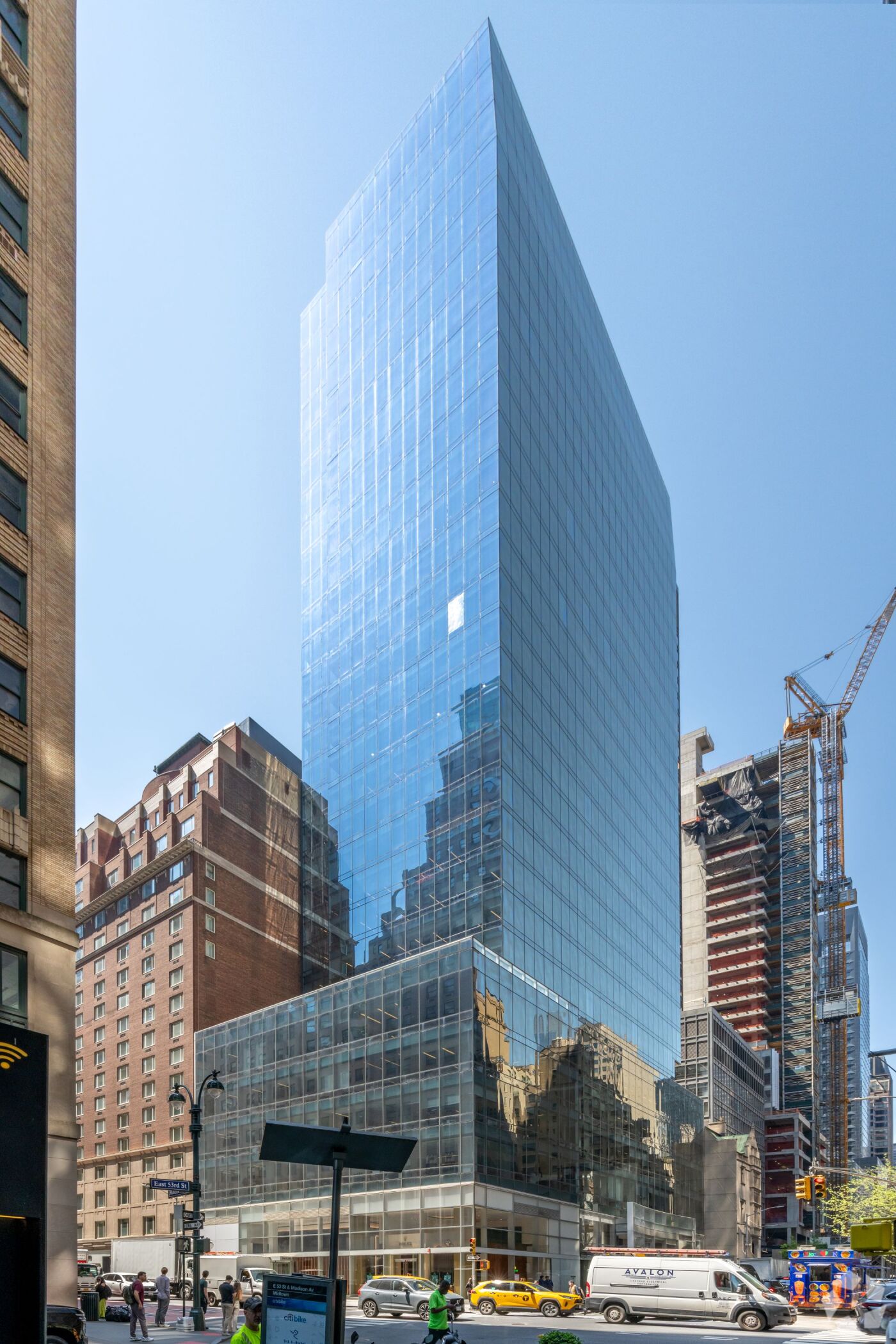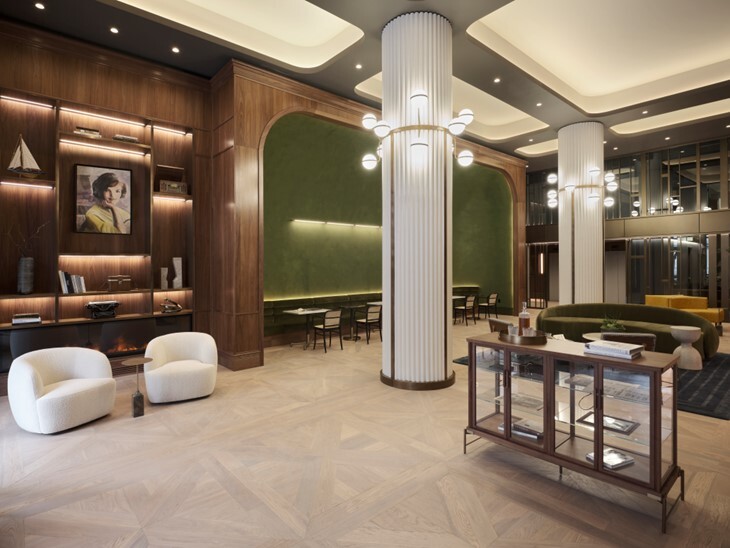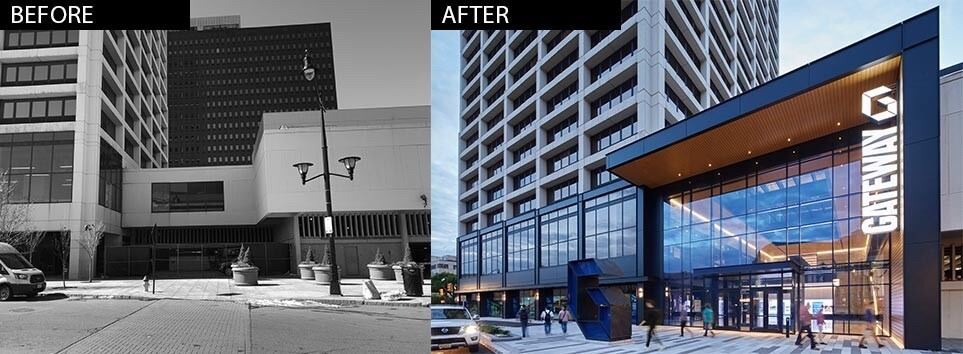While downtown U.S. offices are fuller these days, some landlords are not only still racing to install appealing features to help lure and keep tenants, they are also doing away with some perks considered no longer relevant.
Take 510 Madison Ave., a 30-story building in New York. Owner BXP recently filled in a two-lane, 20-yard-long lap pool and turned the area into a conference center and coffee bar, Beth Leslie, vice president of construction at BXP, said in an interview.
“When we bought the building in 2010, everybody thought [the pool] was really cool," Leslie said at a recent office design panel. But "it wasn’t great. Nobody wants to swim with their coworkers."
Just as smoking rooms have disappeared from office buildings, owners are tearing out dropped ceilings and connecting properties with surrounding streets to meet the latest demands for what's considered a desirable workplace. Instead of just adding amenities as landlords did right after the pandemic, they are now tweaking and calibrating what they offer to build on gains they've made.
The latest focus on amenities comes as the overall U.S. office vacancy rate has reached a record high of 14%, even as it has improved in some markets or in newer buildings, CoStar data shows. Only about half of the 50 largest U.S. office markets have experienced more move-ins than move-outs, or so-called positive absorption, so far in 2025 as first-quarter leasing trends saw companies taking spaces 15%-20% smaller than the 2015-2019 average, according to a CoStar analysis.
Appealing amenities have grown in importance across the United States as major companies including Amazon, Boeing and JPMorgan Chase have called workers back to the office and want to keep them engaged in their workplaces. Employers see updated features as crucial to attracting talent and in the face of post-pandemic hybrid work patterns.
Amenities ‘arms race’
Competing in this “arms race” is crucial as properties that include “a diverse roster of amenities" are expected to see a "12% higher demand from tenants versus their plain commodity counterparts” this year, the brokerage JLL said in a report. Perks with health and wellness, food and beverage, outdoor spaces, and conferencing elements are among the most in demand, different studies have said.
By the 2010s, office landlords sought to replicate the amenities model pioneered in the early 2000s by tech giants such as Google, according to Erin Saven, real estate strategy director at architecture firm Gensler. Nap pods, gourmet food and on-site wellness began popping up in the workplace.

What represents desirable amenities today is still evolving, Saven said in an email, but preferences have shifted “from practical utility to hospitality-driven experiences, redefining how these spaces support office workers in their daily routines.”
Some past projects “overlooked the underlying cultural components” that led to “underutilized and oversized” amenities, Saven said. Landlords now aim to offer “branded, service-driven experiences that anchor a building’s identity and give employees more reasons to look forward to coming into the office,” she said.
Paige Engeldrum, an executive director at Cushman & Wakefield, described health-and-wellness-related perks as key to completing the amenity puzzle.
“When amenity centers were first being constructed, there was such a narrow focus on what health and wellness meant, and it was defined as like a small hotel gym. So a million-square-foot building had this small gym that … nobody wanted to go to,” she said at the design panel, hosted by the New York chapter of Professional Women in Construction.
She said the industry is redefining wellness and moving to create perks that are more “individual” and can meet the needs of employees of different generations and ages as opposed to creating a large-scale gym that was “trying to be everything for everybody.”
Out with the boardroom
In another example of an old amenity making way for a new one, after Marx Realty in 2020 bought the Herald Building at 1307 New York Ave. in Washington, D.C., it removed a boardroom in the lobby, Craig Deitelzweig, Marx's president and CEO, said in an interview.
Visitors walking into the former Washington Times-Herald building, built in 1923, could see who was in the boardroom right away, potentially tipping off passersby to any confidential meetings inside.

The space “didn’t meet the needs of today’s tenants,” Deitelzweig told CoStar News.
Still, he said, “a boardroom is an important amenity," adding that today's tenants "want the exclusivity.” So Marx built a new boardroom, also on the lobby floor, but “tucked away for privacy,” Deitelzweig said. The developer also gave it a different finish, as the old one “was too corporate.” The room's overhaul also included removing a 10-foot drop ceiling, which at one point was in demand, to create a 27-foot ceiling height.
The upgrades are part of a new 15,000-square-foot amenities space on the ground floor that also includes a gym, lounge, cafe and bar, and the building is expected to be 96% leased this fall, Deitelzweig said. That would give Marx bragging rights, with the D.C. market's office vacancy rate at a near-record high of about 17%, CoStar data shows. The updates also made a big difference in cash flow: Per-square-foot rents have jumped to the $70s and $80s from the mid-$20s when Marx bought the property, Deitzelweig said.
Marx, which also owns Manhattan properties such as 10 Grand Central, employs a similar playbook in outfitting properties with hotel-like amenities, including a house car to shuttle tenants around.
Deitelzweig said all of its New York office properties are about fully leased. “We look at our amenities space as a club,” he said.
Connecting tenants with the community
Marx Realty isn't the only landlord that seeks to make its amenities space more like a private club or present a luxury hotel vibe.
Gensler in recent years redesigned the third floor of the former IBM Building at 590 Madison Ave. in Manhattan from a dining, training and conference amenity to a hospitality-inspired amenity spanning 25,000 square feet. Perks include a full-service bar, multisport simulator, library, cafe and meeting areas.
Tiffany Rufrano, asset management director for the State Teachers Retirement System of Ohio, which owns 590 Madison, said the change came as what had been a single-tenant officer tower evolved to become a multi-tenant property.
The state's retirement system agreed to sell the property to RXR Realty for $1.1 billion, according to media reports.

Sometimes the amenities involve the outdoors. Onyx Equities’ bid to reimagine the Gateway Center, a 1970s office complex in Newark, New Jersey, involved rethinking skybridges, building lobbies, and the food and beverage offerings, said Dana Nalbantian, principal at Gensler.
The pedestrian walkways, connected to Newark Penn Station, were originally built to “create a sense of safety and ease” for commuters during a time of civil unrest so they wouldn't have to access the streets in the city, Nalbantian said. The 1.6 million-square-foot office complex now reconnects tenants to the street level and invites visitors in as office designs are increasingly about incorporating tenants and their employees as part of their communities.
The ground floor of the Gateway One building at the complex has been opened up to create a large glass atrium entrance with new food and beverage amenities, keeping the connection to the outside while the skyways remain for direct access to the train station.
As for BXP and 510 Madison Ave., the building has also kept a connection to the past with its renovation, leaving a gym on the same floor where the lap pool was scrapped. The pool "went very much unused," construction executive Leslie said. "Amenities are a baseline. You do need them … but they have to be the right ones.”
